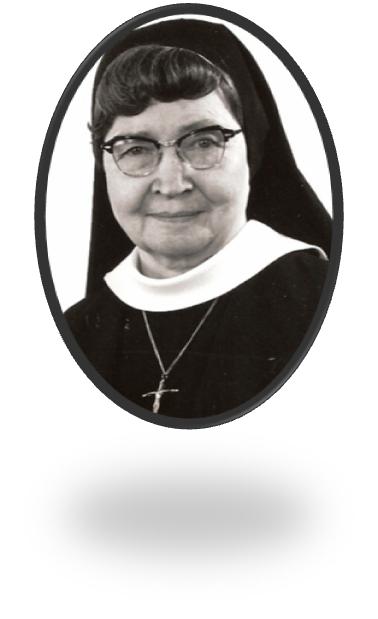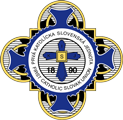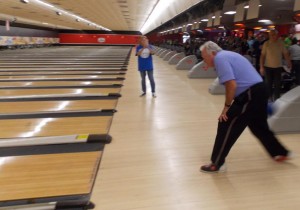It is no secret that immigrants have provided our nation with a strong and blessed support. Our Sisters who emigrated from central Europe have contributed mightily not only by their spiritual presence but also by the works they have performed in convents, parishes, schools, hospitals, homes for the elderly and by their very presence which has brought joy and comfort to all with whom they came into contact. If my calculations are correct, fifty-one Sisters have come to the U. S. to live fruitful lives and to minister to people who always proved to be thankful for their presence. I would like to introduce you to several of these Sisters who made a contribution to the health and well-being of their companions on the journey, especially those whom we called “house Sisters.” Some of them, of course, became teachers in the parish schools and sacristans in parishes and large institutions.
The first Sister I would like to introduce is Sister Bernardine Balint from Bridgeport, CT who knew Father Matthew Jankola and had a spot in his funeral procession.
Sister Bernadette Marie Ondus, SSCM

Her Story: Sister Bernardine
Sister Bernardine was born Mary Balint in Brestov, Slovakia, January 9, 1904, (some of the records call it Austria-Hungary, given the political situation at that time).
In one of her Jubilee stories Sister Bernardine tells us that in her parish church in Slovakia there was a statue of St. Rita. One day when she was only five some Sisters came to her home to take up a collection for an orphanage. Mary thought they were heavenly visitors and that those who dressed like St. Rita lived in heaven.
The story continues with her father returning to Slovakia in 1912 to get “Marinka”and her mother to take them back to the U. S. To make it easier for her to leave Slovakia, he told her she would be taught by Sisters.
Their new home was in Bridgeport, CT, and Father Matthew Jankola was pastor of their church, Saints Cyril and Methodius. At the time of her arrival, Mary was eight-and-a-half. Her sister Anne had been Father’s housekeeper for four years. Father spoke these prophetic words when he met Mary: “Even though Anne didn’t enter the newly-founded Sisters of Saint Cyril and Methodius, maybe Mary will.”
Recalling Father Jankola
Father Jankola was the quintessential pastor. Although his greatest concern was establishing a religious congregation of Sisters to teach the children of immigrants, he did not wait until this would become a reality. His parishioners became the recipients of his ideas to help them grow in their faith and to become productive American citizens. He conducted catechetical classes for public school children, for instance. Father also offered naturalization classes for immigrants applying for citizenship and evening school for adults interested in learning math, English, Slovak, community singing and drama. Naturally, he started a choir and also a drama club.
Mary was twelve when her pastor Father Jankola died at the age of 43. His death was a devastating blow to the entire parish. It is evident that Mary, a twelve-year-old, felt the loss as keenly as all the other parishioners. it conveys the strong regard Mary had for her deceased pastor. She was delighted for the opportunity to be a part of the funeral procession.
As Sister Bernadine recalls: I was twelve years old when Father Jankola, our pastor, died. Stephanie Tybor (Sister Martina’s sister), who was Prefect of the Sodality, chose Mary Valo and me to be the leaders of the schoolgirls in the funeral procession. We wore white dresses and black sashes; some also wore black ribbons in their hair. We slowly entered the church, walked up the aisle and then parted at the railing. My place was under the mission cross. I began to grow very uncomfortable. I had been all right while I was moving around, but now that I was kneeling I became hotter and hotter. I could feel the perspiration pouring down my face. Suddenly blackness came and I fainted. One of the ushers took me out to the side porch and sat me on a chair and said, “Mary, I’ll take you home” “No, no, no—even if I die, I’m going to walk to the cemetery. I loved my pastor and I don’t care if I die.”
Entering Religious Life
Mary entered on March 18, 1919. Earlier that day Sister Bernadette Malaskanic had died. Mother Monica, I.H.M. directress of novices, told Mary, “God will give you many graces and much suffering.” It proved prophetic later in her last days.
Evidently Sister liked to record events that were especially meaningful to her as demonstrated by her account of her role in Father Jankola’s funeral. Here is her account of the arrival of the Sisters of Saints Cyril and Methodius in Danville and their first encounter with their new Motherhouse:
I was the last postulant to enter the Sisters of SS. Cyril and Methodius in Middletown, the site of our temporary Motherhouse. The date was March 18, and although entering a religious community is in itself an exciting venture, little did I realize then that in the early days of our religious life, eight other young ladies and I would embark on an adventure few have ever experienced.
Several months after my entrance, on June 18, 1919, nine postulants and several novices boarded the train at Middletown to travel to Danville to take possession of the mansion that the congregation had purchased for its Motherhouse. Mother Emmanuel, the General Superior, met us at the station with the news that, because of an irregularity in the deed, we would not be able to occupy Castle Grove after all. The high spirits that had marked our trip to Danville were suddenly dashed. Our disappointment knew no bounds. Mother asked us to remain at the station, but the Immaculate Heart Sisters at St. Joseph’s offered our dejected group hospitality for the night. We slept on the floor of the convent on mattresses and blankets provided by the Sisters. The next day after Father Dougherty, the pastor of St. Joseph’s, spoke with us, we received word to proceed to Castle Grove. We quickly collected our luggage, not forgetting to take along the three cats we had brought with us in a box from Middletown. As we walked through town, we commented to one another how quiet and pleasant it was. When he arrived at the gate, Mother Emmanuel led us in a prayer to the Sacred Heart. Then we walked up the narrow path to a spot near the top of the hill where Mother Emmanuel declared a statue of the Sacred Heart would one day be placed. Later a bronze statue of the Sacred Heart was erected on the spot, thanks to a donation made by Mr. and Mrs. T.W. Walsh.
Our first look at the Bennett mansion was forbidding indeed. What was behind the boarded up windows and doors was as yet a mystery. After eating a dinner prepared by Mrs. Scott, the wife of the caretaker, we toured our new home. That night, exhausted from our first day in our very own Motherhouse, we slept soundly on the floor on the large mattresses from the double beds. The next morning we walked to St. Joseph’s for Mass. After our return from church we breakfasted and then began the task of cleaning a building that had been uninhabited for fourteen years. We had brought along some dusters and the Scotts provided other cleaning materials. Later when our beds and other furnishings arrived by train from Middletown, stopping at the station at the foot of the hill where the Buckley Carpet Store is now, the once gloomy mansion became more cheerful and habitable.
Mrs. Scott also loaned us a few of her plates. Additional plates had to be improvised, and since the ornamentation from the chandeliers was flat, it was used as tableware! After housecleaning chores had been completed, the barn and the outdoors demanded our attention. Mr. Scott cut the tall grass and we weeded around the house. We also spent happy hours weeding around the cobblestones that formed the pathways circling the grounds. At mid-morning Mother Monica brought us bread and jelly and milk which we heartily enjoyed as we took a break from our labors.
Doing laundry was another very important and time-consuming task. Until our washer arrived, it was necessary to wash clothes by hand. When we had decided on a spot to hang the bedding, we purchased rope for the clotheslines. For many years after, the novices hung clothes on the lines adjacent to the barns.
Mr. Scott had also planted a vegetable garden and asked that a few of us help him weed and cultivate it. Also from Middletown we had brought a few chickens and when the rest arrived, we housed them in a section of the barn. They had ample room in the courtyard to exercise and peck about for food. One day in preparation for the Reception ceremony Sister Ferdinand and I gave the courtyard a good scrubbing. Then we fed the chickens. I got the feed and Sister Ferdinand held the large door open as she called the chickens to the feast. She suggested letting them in two by two. Suddenly the heavy door collapsed, pinning her and number of the chickens beneath its weight. When I saw Sister was bleeding badly, I ran for Mother Monica who discovered that Sister was quite seriously hurt. While Mother got her medical attention, Sister Madeleine killed and cut up the injured chickens. The survivors went to roost after their fright. Needless to say, the courtyard needed another scrubbing.
We postulants were also commissioned to perform a frightening task—killing the snakes residing in the ruins of the greenhouses located where the cemetery and the statue of St. Joseph are now. Amid the stones, cement and shattered glass were numerous families of snakes. Armed with hoes and pitchforks, postulants and novices set out to exterminate them. After each frontal attack, aiming our weapons at the head of the formidable creatures, we retreated, screaming. Though the tiny ones posed little threat, the large snakes were dauntless as they tried to protect their offspring. After seventy years I can still vividly recall our war against the snakes.
The date for the first Reception in Danville of young women into the congregation had been set for August 15, the Feast of the Assumption. Since the sun-parlor floor was rusty from leaks from both the roof and the radiators, we postulants had to remove the stains with lye. To protect our shoes from the strong solution, we wore our overshoes. The Reception ceremony was held as scheduled, not in the sun parlor, however, but in the chapel. At that time the altar was situated in the back on the sun-parlor side, opposite its present location.
After accomplishing the assigned tasks both inside and outside our Motherhouse, I was sent at the end of August to our elementary school in Jessup. I had 125 first and second graders in my charge. The superior and principal was Sister Elizabeth, who at mid-term came to my classroom to administer tests in all the subjects, reading, writing, spelling, math, and, of course, religion. I spent those three days with Sister’s third and fourth graders. After the testing was over Sister Elizabeth complimented me, telling me how pleased and satisfied she was with the children’s academic progress. I was so relieved for I had feared the worst, being sent home for not fulfilling the responsibility of maintaining a classroom. At the time I started my teaching career I was only 15 years old! In January I turned 16 and continued teaching until the end of the school year when I returned to Danville to be received into the congregation as a novice.
For the next two years my companions and I learned from Mother Monica the basics of religious life. The entire time of preparation for religious profession I consider one of the happiest of my life. On the occasions when all the Sisters, both novices and professed, over 100 by then, gathered together on the lawn, our beautiful, harmonious community spirit was evident. Such bonding had taken place as we all joined our hands and hearts in establishing our Motherhouse at the former Bennett mansion in the peaceful borough of Danville.
Following a Significant Role Model
Sister Bernardine indeed had a significant role model in her pastor, Father Jankola, when it comes to diligence and service. She was a teacher for 46 years. Sister was also principal and superior. During that time she reached out to anyone in need of guidance and instruction. Sister was only a postulant when she was given a teaching assignment in Jessup where she taught 125 children in the first grade. In this class were two future Sisters and two future priests. According to Sister Benardine, “A little portion of ME went into them.” These touching words demonstrate the sort of person she always was. It is not difficult to imagine that Father Jankola himself had such feelings for his people. As a member of the congregation he had founded, Sister proved her diligence and care for the individuals to whom she ministered over many years: she directed altar boys, conducted children’s choirs, taught First Communion and Confirmation classes and instructed converts at a time when there were no RCIA programs in parishes. Among the young ones she instructed in the sacraments of communion and confirmation was a boy with cerebral palsy. From 1930-1932, Sister Bernardine served as Directress of Novices. A special role she fulfilled was that of sacristan at Maria Joseph Manor for 19 years. Father Augustine Zan who also immigrated to the U. S. served as chaplain. According to Sister Paracleta, “Sister Bernardine was known for her conscientious exercise of her responsibilities, reverence for the Eucharist, and the care of the sacred vessels and the linens.”
In 1984, Sister retired to Maria Hall. Another side of her personality became evident on occasions like Mardi Gras and Halloween. Sister was the first to put on a costume for the evening get-togethers, Slovak dress, a bridal outfit, a dress suit with a top hat in the role of MC. It was evident she enjoyed performing and adding humor to the occasion.
The serious side also became evident, especially at the end of her life when she dealt with her illness with patience and resignation. One wonders whether she remembered Mother Monica’s words at the beginning of her life as a Sister: “God will give you many graces and much suffering.” In difficult moments she no doubt uttered this sincere prayer: “Eternal Father, I offer you the wounds of our Lord Jesus Christ to heal the wounds of our souls; my Jesus, pardon and mercy, through the merits of your Sacred Wounds. Jesus, King of Mercy, I trust in you. Sacred Heart of Jesus, have mercy on me.”
At her last moments she may have whispered these words: “Jesus, Mary, Joseph, I give you my heart and my soul; Jesus, Mary and Joseph, assist me in my last agony. Jesus, Mary and Joseph, may I breathe forth my soul in peace with you.”
Her last day on earth was First Friday. She died shortly before 11 p.m. on Friday, October 7, 1994, the Feast of Our Lady of the Rosary.



